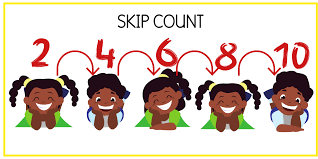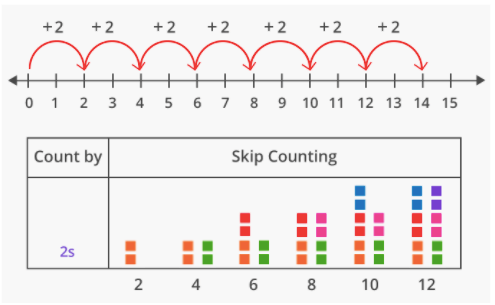Skip Count

Recommended Games
What Exactly Is Skip Counting?
In math, skip counting can be defined as the method of counting forward by numbers other than 1. To skip count means to count by skipping through a particular number of places in the counting sequence. For example, when we skip count by 5, we start from 0, and we skip the next number and go to the fifth number, which will be 5.
So to skip count by 5 would mean to count every fifth number starting from the given number. If we start from 0, we count 0, 5, 10, 15, 20, 25 . . . and so on. Note that each time, we skipped through the numbers in between and directly jumped to the fifth number from our current number.
Skip counting can also mean adding or subtracting a particular number each time to our previous number. For example, if we are to skip count by 10, we would count as 10, 20, 30, 40 . . . and so on. Note that each number in this sequence is 10 more than the previous number.
We can also skip count on the number line by simply jumping by a particular number to make a sequence. As an example, if we were to skip count by 2, starting at 0, the next number will be $0 + 2 = 2$, then, $2 + 2 = 4$, then $4 + 2 = 6$, then $6 + 2 = 8$, and then, 10, 12, 14, 16, 18 and so on.

Similarly, skip counting by 3 will be done by adding 3 to every subsequent number. The resulting series will be as follows:
3, 6, 9, 12, 15, 18, 21, 24, 27, 30, 33, 36, 39, 42, 45, 48, 51, 54, 57, 60 and so on.
Did you notice how the result of skip counting yielded the same answers as the multiplication table of 3?
Skip counting is majorly applied in multiplication tables where you would skip counts to get the answer to a particular multiple. For example, while reading out the multiplication table of 5, if you had to find the multiple of 30, you would skip count by 5 until you reach 30 to determine the multiple, which will be 6.
Recommended Worksheets
Types of Skip Counting
Forward Skip Counting
When we perform forward skip count, we count or add numbers in the forward direction to a number. So, if we were supposed to skip count by 10, we would follow the pattern below:
- $0 + 10 = 10$
- $10 + 10 = 20$
- $20 + 10 = 30$
- $30 + 10 = 40$
- $40 + 10 = 50$
Backward Skip Counting
When we perform backward skip count, it means to subtract a particular number. For example, if we start from 100, and we do backward skip count by 10, it would mean subtracting 10 from each new number and it would become something like 100, 90, 80, 70 . . . and so on.
Solved Examples on Skip Count
1. If you had to count 20 toffees, which of the following counting methods will help you count them all faster?
- Skip counting by 1
- Skip counting by 2
Solution: The correct answer is skip counting by 2. This is because skip counting by 2 will help you count the toffees faster than skip counting by 1.
2. If there are 40 apples in a basket and we need to skip count it by 5, how many times will you need to count the apples?
Solution: In the given question, we are given a total of 40 apples.
If we skip count them by 5, then we will get the following series:
5, 10, 15, 20, 25, 30, 35, 40.
So we will skip count by 5 a total of 8 times to count all 40 apples.
3. Which number would you keep adding to a series of numbers if you want to skip count by 10?
To perform a skip count by 10, we will need to keep adding 10 to the previous number in a series of numbers.
Practice Problems on Skip Count
Skip Counting - Definition With Examples
Suppose you have 100 marbles; how many times will you need to perform skip counting by 20?
If we skip count by 20, we get:
20, 40, 60, 80, 100.
Thus, we skip counted 5 times to get to 100.
Which series denotes skip counting by 9 starting from 0?
Skip counting by 9 starting from 0 would mean that we will obtain the multiplication table of 9 which is 0, 9, 18, 27, 36, 45 . . .
Which option shows backward skip counting 5 starting from 100?
When we do a backward skip count by 5, starting from 100, we subtract 5 from each new term and we get the series 100, 95, 90, 85, 80, 75 and so on.
Frequently Asked Questions on Skip Count
Is skip counting useful for mathematical learning?
Skip counting can help learners understand the mathematical function of multiplication. It can help students learn tables quicker.
How do we perform skip counting?
Skip counting is a method of counting numbers by skipping a fixed number in accordance with the preceding number. For example, to skip count by 5 starting from 0, we count every fifth number and we get 0, 5, 10, 15, 20 . . .
Is there any significance of skip counting in daily life?
In mathematics, skip counting is a vital skill that is likely to help kids perform multiplication with ease. Students can use this method while counting money by a particular denomination or while counting objects.




































